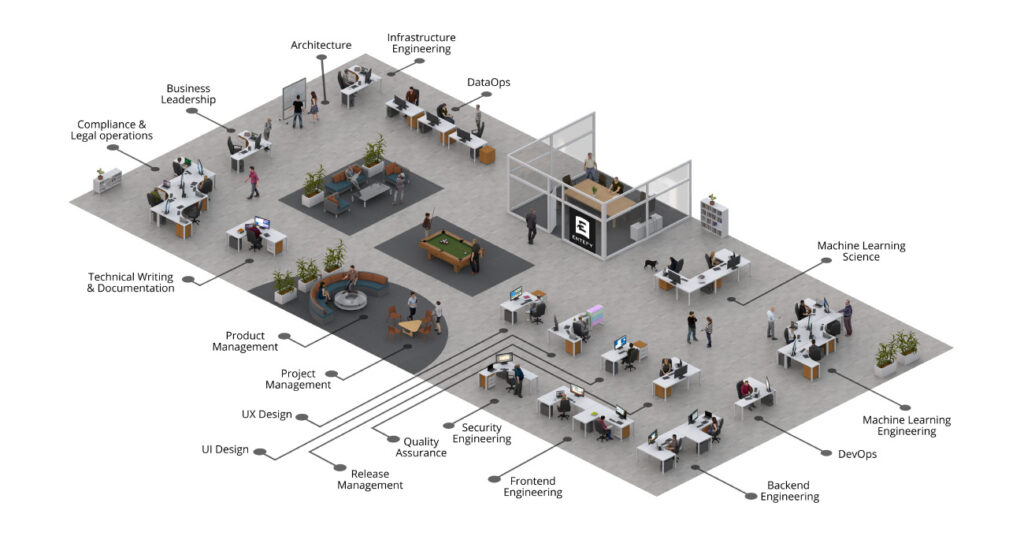Today, artificial intelligence (AI) is among the top technologies transforming industries and disrupting software across the globe. Organizations are quickly realizing the incredible value that AI can add in process and workflow automation, workforce productivity, cost reduction, energy and waste optimization, customer engagement, and much more.
AI and machine learning rely on a special blend of science and engineering to create intelligence for machines—preparing data, choosing algorithms, training models, tuning parameters, testing performance, creating workflows, managing databases, developing software, and more. Building models and architecting thoughtful software orchestration are central to work in this field and continual experimentation is simply par for the course. However, this is only part of the AI journey.
At Entefy, we’re obsessed with machine intelligence and its potential to change lives for the better. Given our work in advanced AI and intelligent process automation over the years and various inventions in the field, we’ve had the good fortune of working with amazing people to build systems that bring unprecedented efficiency to operations.
So, what does it take to make it all work and work well? What are the proficiencies and competencies required to bring useful and scalable AI applications to life? Below are 18 valuable skills organizations need in order to successfully materialize each AI project from ideation to production implementation.
18 Skills needed for enterprise AI
Architecture: Design and specification of software subsystems, supporting technologies, and associated orchestration services to ensure scalable and performant delivery.
Infrastructure Engineering: Implementation and maintenance of physical and virtual resources, networks, and controls that support the flow, storage, and analysis of data.
DataOps: Management, optimization, and monitoring of data retrieval, storage, transformation, and distribution throughout the data life cycle including preparation, pipelines, and reporting.
Machine Learning Science: Research and development of machine learning models including designing, training, validation, and testing of algorithmic models.
Machine Learning Engineering: Development and software optimization of machine learning models for scalable deployment.
DevOps: Building, packaging, releasing, configuring, and monitoring of software to streamline the development process.
Backend Engineering: Development of server-side programs and services including implementation of core application logic, data storage, and APIs.
Frontend Engineering: Development of client-side applications and user interfaces such as those present in websites, desktop software, and mobile applications.
Security Engineering: Implementation and management of policies and technologies that protect software systems from threats.
Quality Assurance: Quality and performance testing that validates the business logic and ensures the proper product function.

Release Management: Planning, scheduling, automating, and managing the testing and deployment of software releases throughout a product lifecycle.
UI Design: Wireframing, illustrations, typography, image, and color specifications that help visually bring user interfaces to life.
UX Design: Specification of the interaction patterns, flows, features, and interface behaviors that enhance accessibility, usability, and overall experience of the user interaction.
Project Management: Coordination of human resources, resolution of dependencies, and procurement of tools to meet project goals, budget, and delivery timeline.
Product Management: Scoping user, business, and market requirements to define product features and manage plans for achieving business goals.
Technical Writing and Documentation: Authoring solution and software specifications, usage documentation, technical blogs, and data sheets.
Compliance and Legal Operations: Creation and monitoring of policies and procedures to ensure a solution’s adherence to corporate and governmental regulations through development and deployment cycles, including IP rights, data handling, and export controls.
Business Leadership: Strategic decision making, risk assessment, budgeting, staffing, vendor sourcing, and coordination of resources all in service of the core business and solution objectives.
Conclusion
It takes a village to nurture an AI project. Whether you have people within your team or rely on external support, the resources are available to bring your AI initiatives to life. Begin your enterprise AI journey here. And be sure to check out our other resources to help you shorten your project implementation time and avoid common AI missteps.
